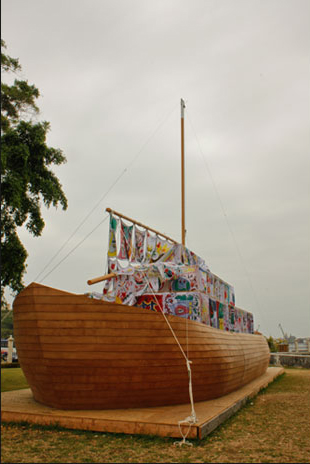With its commanding presence and message of peace and unity, Ilya and Emilia Kabakov‘s Ship of Tolerance stood out amidst the other artworks at the eleventh annual Havana Biennial, in May of 2012.
The Ship of Tolerance project was modeled after an ancient Egyptian sailing craft. They supplied history and art books and collaborated with local teachers to conduct workshops. With the help of a volunteer artist, the eager youngsters incorporated what they learned into their own paintings of ships, which were printed onto the structure’s sail.
Inspired by the UN’s International Day for Tolerance, each incarnation of the ship has engaged children between the ages of six and twelve on tolerance workshops that are designed around the reality of each locale. In each manifestation, children paint what tolerance means to them and marvel at the sight of their artwork adorning the ship’s sailcloth.
The children’s interpretation of tolerance is as varied as the areas the paintings are created within. For example, the Cuban ship features one boy’s painting of a spider sitting motionless in the middle of a web, surrounded by flies. He explains that the spider is tolerant because he sees a whole bunch of flies, which he doesn’t like, but he curbs his desire to destroy them.
Following Siwa, Egypt; Venice, Italy; San Moritz, Switzerland; Sharjah, UAE; and Miami, USA, Havana marked the sixth embodiment of the ship. Originally the artists intended to construct two ships and simultaneously unveil one in Miami and the other in Havana, celebrating the historical and cultural ties between the two. Unfortunately, this proved politically impossible. As a compromise, one ship graced Miami’s shores during Art Basel and another resided on the grounds of Old Havana’s historic fortress, Castillo de la Real Fuerza, for the duration of the Biennial. After that, it was given to the Maritime Museum, where children continue the conversation through educational programs at the institution.
Even this arrangement met political opposition in the U.S.—but the Kabakovs persevered. “My argument to the state department was this,” Emilia explains. “Firstly, if we deal with China, which is Communist, why can’t we deal with Cuba? And moreover, how do you explain to the American children, who are taught they live in the most democratic country in the world, why their government won’t allow them to travel to Cuba to perform songs about peace with other children?”
Emilia’s unrelenting phone calls diminished whatever concerns held by the State and Treasury Departments, who ultimately gave the project the green light. The license required for the American children to participate in the opening ceremony arrived a mere four days before the Kabakovs departed for Havana.
Crafted by carpenters from Manchester, the ship embodies the spirit of inclusivity, tolerance, and peace that characterize the project in its entirety. Young apprentices accompanied the carpenters to Havana, where they, along with nine students from the carpentry school in Old Havana, worked without ceasing for more than two and a half weeks to complete construction. It was the young artisans’ first encounter with foreigners, which provided a rewarding experience. “Despite the language barriers, everyone got along very well,” Emilia says. “They were smiling the whole time, even though the work was tiring.”






